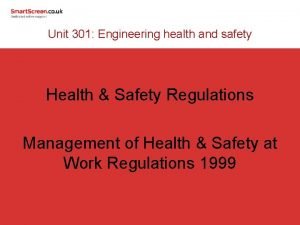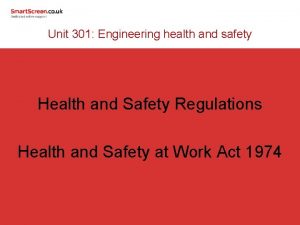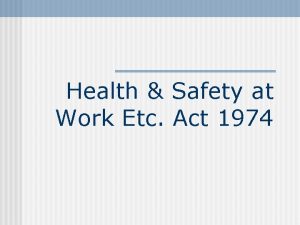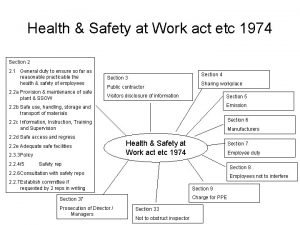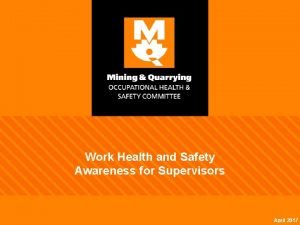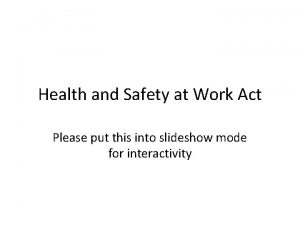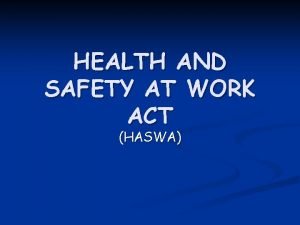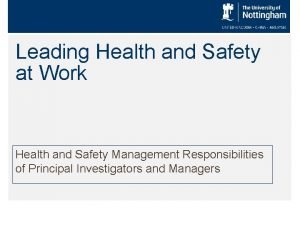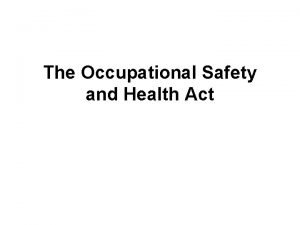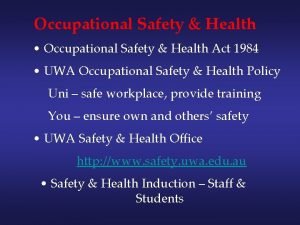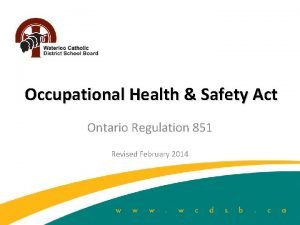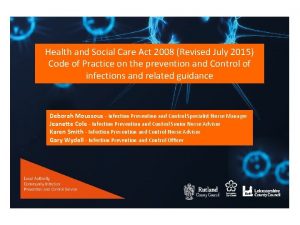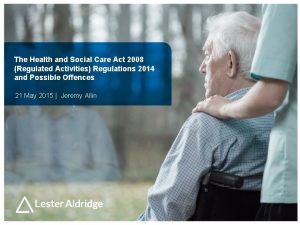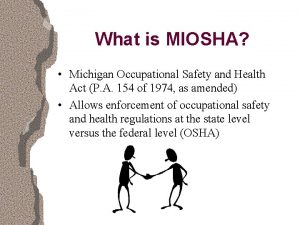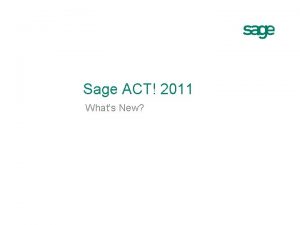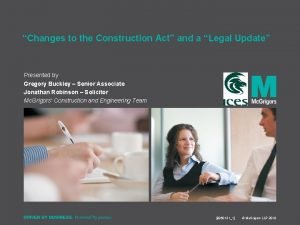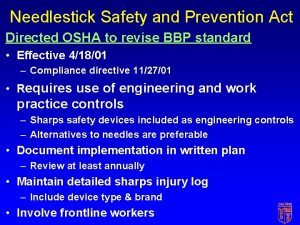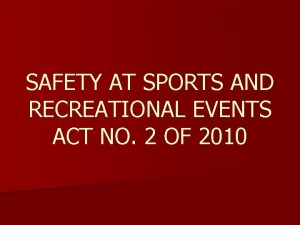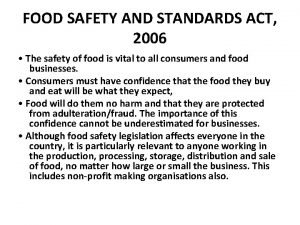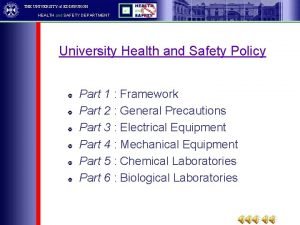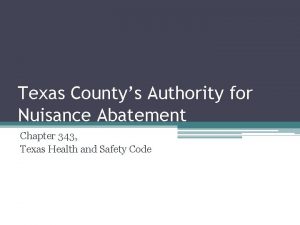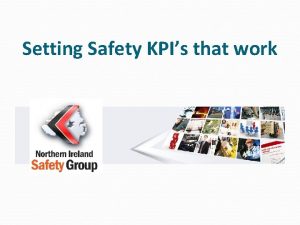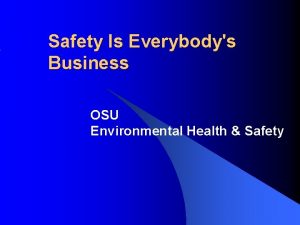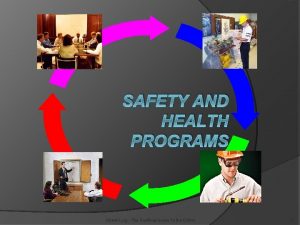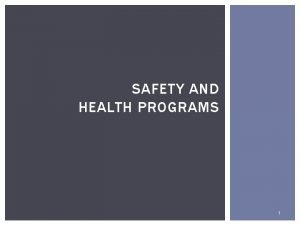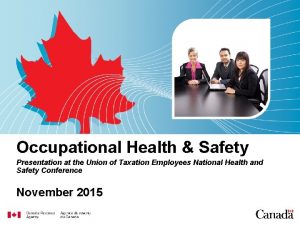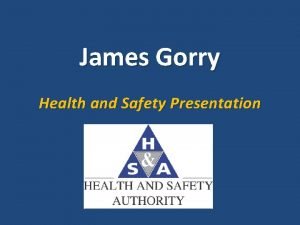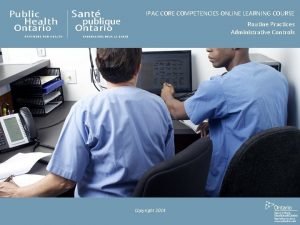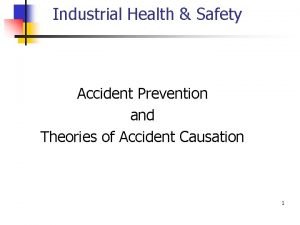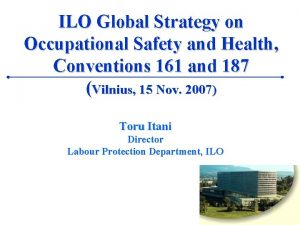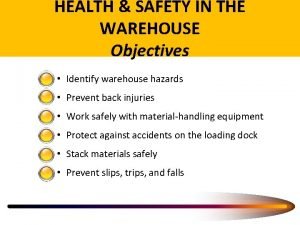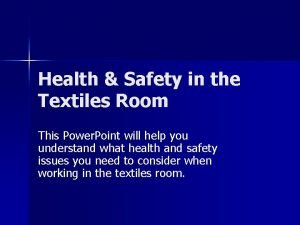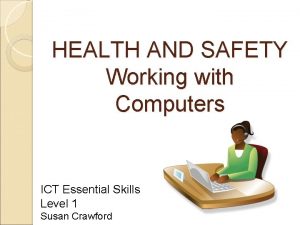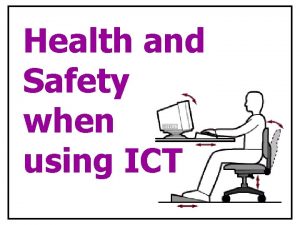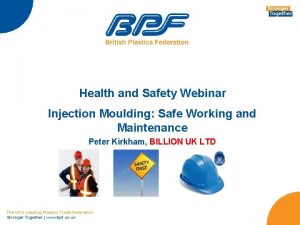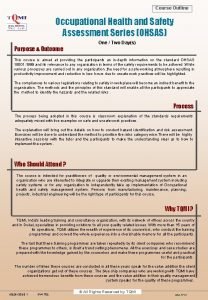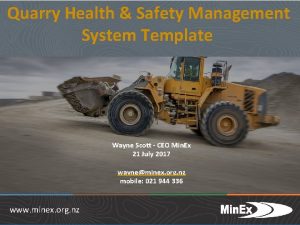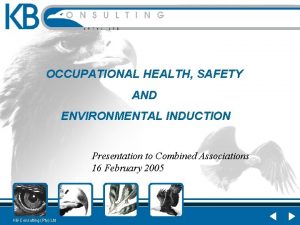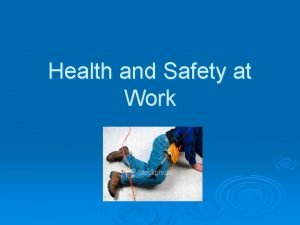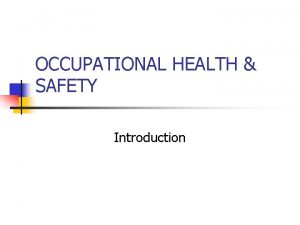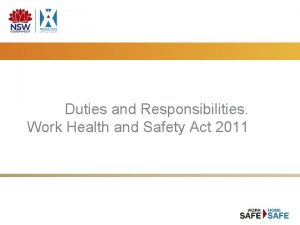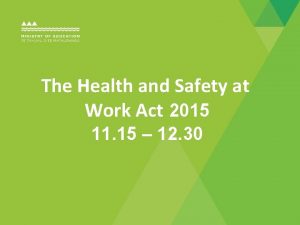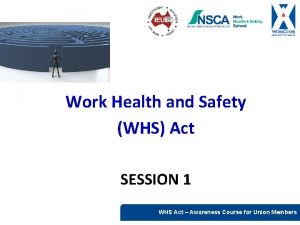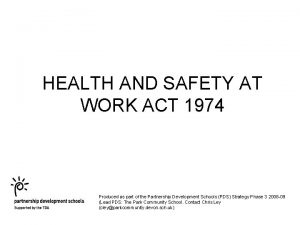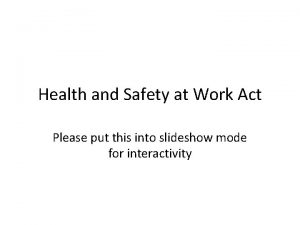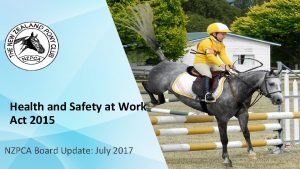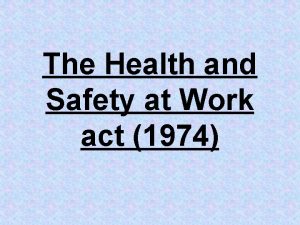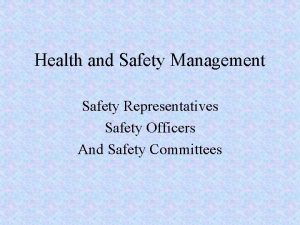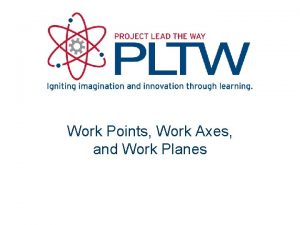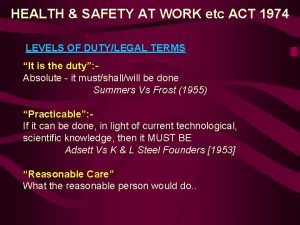Work Health and Safety Act 2011 Application of















































- Slides: 47

Work, Health and Safety Act 2011

Application of Act “This Act binds all persons including the State and, so far as the legislative power of the Parliament permits, the Commonwealth and the other States. The State, the Commonwealth and the other States are liable for an offence against this Act. The State, the Commonwealth and the other States are liable for a contravention of a WHS civil penalty provision. ”

Application to public authorities that are bodies corporate or local governments Proceedings may be taken under this Act against a public authority in its own name. Proceedings may be taken under this Act against a local government, and a local government may be prosecuted and punished, as if it were a body corporate.

Officer of public authority “A person who makes, or participates in making, decisions that affect the whole, or a substantial part, of the business or undertaking of a public authority is taken to be an officer of the public authority for the purposes of this Act. ”

Imputing conduct to public authorities “(1) Any conduct engaged in on behalf of a public authority by an employee, agent or officer of the public authority acting within the actual or apparent scope of his or her employment, or within his or her actual or apparent authority, is conduct also engaged in by the public authority. (2) If an offence against this Act requires proof of knowledge, intention or recklessness, it is sufficient to prove that the person mentioned in subsection (1) had the relevant knowledge, intention or recklessness. (3) If for an offence against this Act mistake of fact is relevant to determining liability, it is sufficient in proceedings for that offence, if the person mentioned in subsection (1) made that mistake of fact. ”

Management of risks A duty imposed on a person to ensure health and safety requires the person— (a) to eliminate risks to health and safety, so far as is reasonably practicable; and (b) if it is not reasonably practicable to eliminate risks to health and safety, to minimise those risks so far as is reasonably practicable.

Basic Safety Principle “Regard must be had to the principle that workers and other persons should be given the highest level of protection against harm to their health, safety and welfare from hazards and risks arising from work or from particular types of substances or plant as is reasonably practicable. ”

Objects of Work Health and Safety Act 2011 To provide for a balanced and nationally consistent framework to secure the health and safety of workers and workplaces by— (a) protecting workers and other persons through the elimination or minimisation of risks ; and (b) providing for fair and effective workplace representation, consultation, cooperation and issue resolution; and (c) encouraging unions and employer organisations to take constructive role in promoting improvements in work health and safety practices; and

Objectives (cont) (d) promoting the provision of advice, information, education and training; and (e) securing compliance through effective and appropriate compliance and enforcement measures; and (f) ensuring appropriate scrutiny and review of actions by persons exercising powers and performing functions ; and (g) providing a framework for continuous improvement and progressively higher standards of work health and safety; and (h) maintaining and strengthening the national harmonisation of laws relating to work health and safety and to facilitate a consistent national approach to work health and safety in Queensland.

Work Health & Safety "You have to be very serious in terms of having a genuine commitment by management to produce a safe workplace, to put resources behind your decisions, to train people, to make sure culture in the enterprise is one of respectful safety. " 10

Primary duty of care A person conducting a business or undertaking must ensure so far as is reasonably practicable the health and safety of: workers engaged or caused to be engaged workers whose activities in carrying out work are influenced or directed by the person Other persons at risk from work carried out

Further duties A person conducting a business or undertaking must ensure, so far as is reasonably practicable— (a) the provision and maintenance of a work environment without risks to health and safety; and (b) the provision and maintenance of safe plant and structures; and (c) the provision and maintenance of safe systems of work; and (d) the safe use, handling and storage of plant, structures and substances; and (e) the provision of adequate facilities for the welfare of workers in carrying out work for the business or undertaking, including ensuring access to those facilities; and (f) the provision of any information, training, instruction or supervision to protect all persons from risks to their health and safety arising from work carried out; and (g) that the health of workers and the conditions at the workplace are monitored for the purpose of preventing illness or injury of workers

Duties of persons conducting businesses Duty of persons conducting businesses or undertakings involving: Persons with management or control of fixtures, fittings or plant; Designers of plant, or a substance, or a structure; A manufacturer of plant, or a substance, or a structure; An importer of plant , or a substance, or a structure; A supplier of plant , or a substance, or structure; A person who installs plant , or a substance, or a structure; A person who commissions plant , or a substance, or a structure; that is to be used, or could reasonably be expected to be used at a workplace.

Duty of officers, workers and other persons If a person conducting a business or undertaking has a duty or obligation under this Act, an officer of the person conducting the business or undertaking must exercise due diligence to ensure that the person conducting the business or undertaking complies with that duty or obligation.

Duties of workers While at work, a worker must— (a) take reasonable care for his or her own health and safety; and (b) take reasonable care that his or her acts or omissions do not adversely affect the health and safety of other persons; and (c) comply, so far as the worker is reasonably able, with any reasonable instruction that is given by the person conducting the business or undertaking to allow the person to comply with this Act; and (d) co-operate with any reasonable policy or procedure of the person conducting the business or undertaking relating to health or safety at the workplace that has been notified to workers.

Duties of other persons at the workplace A person at a workplace, whether or not the person has another duty under this part, must— (a) take reasonable care for his or her own health and safety; and (b) take reasonable care that his or her acts or omissions do not adversely affect the health and safety of other persons; and (c) comply, so far as the person is reasonably able, with any reasonable instruction that is given by the person conducting the business or undertaking to allow the person conducting the business or undertaking to comply with this Act.

Workers an employee a contractor or subcontractor; a contractor's or subcontractor's employees or an employee of a labour hire company working in the business; an outworker; or an apprentice or trainee; a student gaining work experience; or a volunteer; or a person of a prescribed class

Meaning of workplace A workplace is a place where work is carried out for a business or undertaking and includes any place where a worker goes, or is likely to be, while at work. Place includes— (a) a vehicle, vessel, aircraft or other mobile structure; and (b) any waters and any installation on land, on the bed of any waters or floating on any waters.

The reasonably practicable test Actions which are, or were at a particular time, reasonably able to be done in relation to ensuring health or safety, taking into account and weighing up all relevant matters, including: the likelihood of the hazard or risk concerned occurring the degree of harm that might result from the hazard or risk what the person concerned knows or ought reasonably to know about the hazard or the risk ways of eliminating or minimising the risk the availability and suitability of ways to eliminate or minimise risk the associated cost and whether the cost is grossly disproportionate to the risk


What is a notifiable incident In this Act, notifiable incident means— (a) the death of a person; or (b) a serious injury or illness of a person; or (c) a dangerous incident.

What is a serious injury or illness In this part, serious injury or illness of a person means an injury or illness requiring the person to have— (a) immediate treatment as an in-patient in a hospital; or (b) immediate treatment for— (i) the amputation of any part of his or her body; or (ii) a serious head injury; or (iii) a serious eye injury; or (iv) a serious burn; or -----

What is a serious injury or illness (v) the separation of his or her skin from an underlying tissue (for example, degloving or scalping); or (vi) a spinal injury; or (vii) the loss of a bodily function; or (viii) serious lacerations; or (c) medical treatment within 48 hours of exposure to a substance

What is a dangerous incident A dangerous incident means an incident in relation to a workplace that exposes a worker or any other person to a serious risk to a person’s health or safety emanating from an immediate or imminent exposure to— (a) an uncontrolled escape, spillage or leakage of a substance; or (b) an uncontrolled implosion, explosion or fire; or (c) an uncontrolled escape of gas or steam; or (d) an uncontrolled escape of a pressurised substance; or (e) electric shock; or (f) the fall or release from a height of any plant, substance or thing; or ------

What is a dangerous incident (g) the collapse, overturning, failure or malfunction of, or damage to, any plant that is required to be authorised for use under a regulation; or (h) the collapse or partial collapse of a structure; or (i) the collapse or failure of an excavation or of any shoring supporting an excavation; or (j) the inrush of water, mud or gas in workings, in an underground excavation or tunnel; or (k) the interruption of the main system of ventilation in an underground excavation or tunnel; or (l) any other event prescribed under a regulation

Duty to notify of notifiable incidents (1) A person who conducts a business or undertaking must ensure that the regulator is notified immediately after becoming aware that a notifiable incident arising out of the conduct of the business or undertaking has occurred. (2) The notice must be given as required under this section and by the fastest possible means.

Duty to preserve incident sites (1) The person with management or control of a workplace at which a notifiable incident has occurred must ensure so far as is reasonably practicable, that the site where the incident occurred is not disturbed until an inspector arrives at the site or any earlier time that an inspector directs. (2) A reference to a site includes any plant, substance, structure or thing associated with the notifiable incident. (3) Does not prevent any action— (a) to assist an injured person; or (b) to remove a deceased person; or (c) that is essential to make the site safe or to minimise the risk of a further notifiable incident; or (d) that is associated with a police investigation; or (e) for which an inspector or the regulator has given permission.

Penalties Categor y Description Category 1 Most serious cases - breach of the Category 1 primary (general) duty involving is a criminal recklessness and serious harm (fatality or serious injury) to a offence person or a risk of such harm Maximum Penalty Corporation = $ 3. 534, 500 Individual = $706, 800 Imprisonment - up to five years Workers and other persons = $353, 400 Imprisonment - up to five years Category 2 Breach of the primary (general) Corporation = $1, 767, 000 duty where serious harm or the risk Individual officers = $353, 400 of it without the element of Workers and other persons = recklessness $176, 700 Category 3 Breach of the duty that does not involve high risk of serious harm Corporation = $589, 000 Individual officer = $117, 800 Workers and other persons = $58, 900


Some key points The Work Safety and Health Act 2011 requires active engagement in the health and safety processes requires active engagement in verifying that systems are practised requires greater consideration of the elimination, substitution, isolation and engineering controls and only using administrative controls and PPE as additional controls

Hierarchy of hazard control

Hierarchy of hazard control Elimination: Safety in design method to remove the hazard completely eg reduce exposure to confined spaces, stairway instead of ladders, plugs for electrical isolation Substitution: Replace the hazard with a lesser hazard. Be careful to assess what new risks the substitute may pose. Engineering: Make changes to the process, equipment or plant to reduce the hazard. e. g. change to ‘wet’ processes to reduce dust, enclose or isolate the hazard, install ventilation systems. Administrative: Establishing policies and procedures to minimise the risks, job scheduling to limit exposure, job risk assessments, posting hazard signs, restricting access, training. Behaviour: Following safe work practices, workplace good housekeeping, personal hygiene practices. Create a culture of safety. PPE: Personal Protective Equipment provides a barrier between the wearer and the hazard. PPE items include respirators, safety goggles, blast shields, hard hats, hearing protectors, gloves, face shields, and footwear

Systems Thinking to Integrating Safety A systems-thinking approach to safety allows consideration of more complex relationships between safety-related events. Provides a way to look more deeply at why accidents occur. A system can consist of the interaction between people, machines and the work environment. The environment is where conditions for unsafe acts, unsafe supervision, and organizational influences on safety can be discovered. Knowing one part of a system enables knowledge of interaction with another part. Using systems theory encourages the adoption of a systems perspective (avoid linear, unidirectional, causation) and focuses on interrelationships and processes that produce change (avoid cause-and-effect chains).

Accident Causation – Swiss Cheese Model Systems Thinking to Integrating Safety http: //ehs. ucr. edu/safety/systems

Analyse Unsafe Acts Errors Violations Decisions Wilful disregard for Skill based Perceptual the rules and regulations Intentionally exceed capacity of equipment

Analyse Conditions Substandard Conditions Adverse mentality Adverse physiology Physical /Mental limitations Substandard Practices Human resource management Personal readiness

Analyse Supervision Supervised Planned inappropriate Failed to Correct Violations of inadequately problem Operations Supervisor

Analyse Organisation Resource Management: people, money, equipment/facilities Organisational Climate: working atmosphere culture, structure, chain of command, accountability Organisational Process: oversight, safety, risk management

Integrating Safety Research has indicated that “low-accident companies” differed from “highaccident companies” because they possessed the following organizational characteristics: Strong senior management commitment, leadership, and involvement in safety Closer contact and better communications between all organizational levels Greater hazard control and better housekeeping A mature, stable workforce Good personnel selection, job placement, and promotion procedures Good induction and follow-up safety training

Integrating Safety Ongoing safety schemes reinforcing the importance of safety, including hazard and “near miss” reporting Acceptance that the promotion of a safety culture is a long term strategy requiring sustained effort, involvement and interest Adoption of a formal health and safety policy, supported by adequate codes of practice and safety standards Communication that health and safety is equal to other business objectives Thorough investigations of all accidents and near misses Regular auditing of safety systems to provide information feedback and continuous improvement Source: Cooper, D. (2001). Improving safety culture: A practical guide. Hull, United Kingdom: Applied Behavioural Sciences.

Risk Management Approach The “Hierarchy of Controls” should be used at all times when implementing controls to eliminate the hazard or reduce the risk of a hazard causing loss / damage / injuries. The hierarchy of hazard controls is a list which emphasises controlling a hazard at the source. Giving preference to the use of the ‘engineering controls’ - less subject to human failure; less disruptive and uncomfortable for people working in the area. Back-up controls (such as PPE and administrative controls) should only be used as a support to other control measures – not instead of. Preference given to more than one control method. Regular monitoring is important to make sure that the control is working effectively and that exposure to the hazard is reduced or eliminated.

Consultation is an imperative Must consult with other persons who have duties (e. g. contractors or other companies operating in the same premises) Must, so far as is reasonably practicable, consult with workers who carry out work for the business, or who are likely to be directly affected by a matter relating to work health or safety Remember - workers includes contractors

Consultation includes that: Consultation is required when: Consultation Obligations (cont) • relevant information is shared with • identifying hazards and assessing workers risks • workers are given a reasonable opportunity to express their views and to raise work health or safety issues • making decisions about ways to eliminate or minimise those risks • workers are given a reasonable • making decisions about the opportunity to contribute to decision adequacy of facilities for the making welfare of workers • the views of workers are taken into account • proposing changes that may affect the health and safety of workers • workers are advised of outcomes • making decisions on certain WHS

The due-diligence "checklist" Acquire and keep up-to-date knowledge of WHS matters Understand operations and associated hazards and risks Provide resources and processes for risk elimination or minimisation Provide process for receiving, considering and ensuring timely response to information about incidents hazards and risks Provide process for compliance with WHS duties and obligations

Unpacking due diligence Acquire and keep up-to-date knowledge of WHS matters is broad enough to encompass legislation case law new or key amendments to Codes of Practice industry guidelines best practice guidance – experts Ignorance is not an excuse

Summary What is safe does not change, however, management of your safety obligations amongst such a complex overlay of current and changing legislation requires: • understanding of obligations • communication • management plans • reporting/audit system • constant vigilance • proactive response diligent proactive innovative engaged

 What are the 4 c's in health and safety
What are the 4 c's in health and safety Health and safety at work act engineering
Health and safety at work act engineering Health and safety at work act 1974 section 2
Health and safety at work act 1974 section 2 Health and safety at work act
Health and safety at work act Work health and safety regulations 2012 sa
Work health and safety regulations 2012 sa Health and safety at work act 1984
Health and safety at work act 1984 Haswa
Haswa Leading health and safety at work
Leading health and safety at work Health and safety at work
Health and safety at work Objective of occupational health
Objective of occupational health Occupational safety and health act 1984
Occupational safety and health act 1984 Regulation 851
Regulation 851 Health and safety care act 2008
Health and safety care act 2008 Health and social care act regulated activities
Health and social care act regulated activities What is miosha
What is miosha Macbeth act 3-5 summary
Macbeth act 3-5 summary Sage act 2011
Sage act 2011 Construction act 2011 payment terms
Construction act 2011 payment terms Core standards in nursing
Core standards in nursing Chapter 4 work and energy section 1 work and machines
Chapter 4 work and energy section 1 work and machines Health and social care component 3 health and wellbeing
Health and social care component 3 health and wellbeing Needlestick safety and prevention act
Needlestick safety and prevention act Child protection and toy safety act
Child protection and toy safety act Safety at sports and recreational events act
Safety at sports and recreational events act Food safety act 2006
Food safety act 2006 Safety and health edinburgh
Safety and health edinburgh Standard 1 care certificate answers
Standard 1 care certificate answers Texas health and safety code 343
Texas health and safety code 343 Six pack health and safety regulations
Six pack health and safety regulations Health and safety kpis
Health and safety kpis Osu ehs training
Osu ehs training Benefits of a safety and health program
Benefits of a safety and health program Benefits of a safety and health program
Benefits of a safety and health program Health and safety in hrm
Health and safety in hrm Occupational health and safety presentation
Occupational health and safety presentation James gorry health and safety
James gorry health and safety Ipac administrative controls answers
Ipac administrative controls answers Human factors theory
Human factors theory Global strategy on occupational safety and health
Global strategy on occupational safety and health Warehousing health and safety
Warehousing health and safety Safety in the textiles room
Safety in the textiles room Health and safety in ict
Health and safety in ict Ict health and safety
Ict health and safety Health and safety injection moulding
Health and safety injection moulding Occupational health and safety course outline
Occupational health and safety course outline Textiles health and safety
Textiles health and safety Food safety management system template
Food safety management system template Safety induction slide
Safety induction slide
